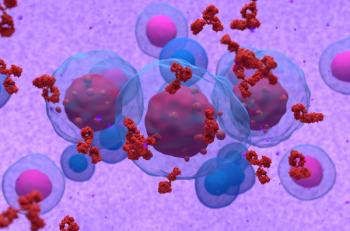
Neoadjuvant Pembrolizumab Plus Chemotherapy Followed by Adjuvant Pembrolizumab Is New Standard of Care for High-Risk Early-Stage TNBC
Overall survival results from the phase 3 KEYNOTE-522 study provide evidence of improved long-term outcomes from this pembrolizumab-based regimen.
Based on late-breaking data from the KEYNOTE-522 (NCT03036488) study, adding pembrolizumab (Keytruda; Merck) to chemotherapy as pre-operative (neoadjuvant) treatment and then continuing as a single agent after surgery (adjuvant) in patients with high-risk early-stage triple-negative breast cancer (TNBC) significantly improved pathological complete response (pCR) rates and event-free survival (EFS). Peter Schmid, FRCP, MD, PhD, presented these data at the European Society for Medical Oncology (ESMO) Congress 2024 in Barcelona, Spain during a presidential symposium.1
In this landmark phase 3, randomized controlled trial, investigators examined the role of neoadjuvant pembrolizumab, an anti-PD-1 therapy, or placebo plus chemotherapy followed by adjuvant pembrolizumab or placebo for high-risk early-stage TNBC. Schmid explained that after a median follow-up of 75.1 months (range, 65.9-84.0), the pembrolizumab regimen significantly improved overall survival (OS), a key secondary end point of the trial, reducing the risk of death by 34% (HR=0.66 [95% CI, 0.50-0.87]; P=0.0015) in patients with high-risk early-stage TNBC compared to the chemotherapy-placebo regimen. Additionally, the 5-year OS rate was 86.6% (95% CI, 84.0-88.8) for patients who received the pembrolizumab regimen vs 81.7% (95% CI, 77.5-85.2) for patients who received the chemotherapy-placebo regimen.1,2
Following Schmid’s presentation of the data at ESMO Congress 2024, Marleen Kok, MD, PhD, provided an expert discussion on the clinical implications of the trial results, emphasizing their transformative potential for the treatment of high-risk early-stage breast cancer treatment, while noting some remaining questions regarding the future of clinical research investigating TNBC treatment.1
The KEYNOTE-522 Study Design
Schmid, lead in the Centre for Experimental Cancer Medicine at Barts Cancer Institute in London, England, explained that TNBC is an aggressive and difficult-to-treat subtype of breast cancer. In the KEYNOTE-522 study, investigators enrolled 1174 patients who were randomized 2:1 to pembrolizumab or placebo in combination with chemotherapy. In the pembrolizumab regimen, patients received pembrolizumab plus chemotherapy (paclitaxel and carboplatin), followed by pembrolizumab plus chemotherapy (cyclophosphamide and either doxorubicin or epirubicin) as neoadjuvant therapy, followed by pembrolizumab monotherapy as adjuvant therapy (n=784). In the chemotherapy-placebo regimen, patients received placebo plus chemotherapy (paclitaxel and carboplatin), followed by placebo plus chemotherapy (cyclophosphamide and either doxorubicin or epirubicin) as neoadjuvant therapy, followed by placebo monotherapy as adjuvant therapy (n=390).1
The study had 2 primary end points: pathological complete response (pCR) and event-free survival (EFS), both of which were met in earlier interim analyses. Based on these previously presented results, pembrolizumab was approved by the FDA in combination with chemotherapy as neoadjuvant treatment and then continued as a single agent as adjuvant treatment after surgery for the treatment of patients with high-risk early-stage TNBC. The trial data from KEYNOTE-522 also supported regulatory approvals for certain patients with TNBC in Europe, Japan, and other countries globally.1,2 However, the final OS data, presented at ESMO Congress 2024, provided the most compelling evidence for pembrolizumab's role in improving long-term outcomes for patients with TNBC, according to Schmid.1
“Neoadjuvant pembrolizumab and chemotherapy followed by adjuvant pembrolizumab continues to show a clinically meaningful improvement in EFS. The data are plateauing over the last few years with neoadjuvant chemotherapy alone, after a median follow up of over 6 years,” Schmid said during the ESMO presentation. “With this longer follow up, the toxicity profile remained consistent with the previous analyses and the established safety profiles of pembrolizumab and chemotherapy. We did not observe any new safety concerns. These results provide further support for neoadjuvant chemotherapy and pembrolizumab with a platinum-containing chemotherapy regimen after surgery and pembrolizumab after surgery as a standard of care for patients with high-risk stage II or stage III early [TNBC].”1
OS Data: A Milestone for TNBC
The results of the OS data from KEYNOTE-522 are a significant milestone, as pembrolizumab is the first immunotherapy-based regimen to show a statistically significant and clinically meaningful improvement in OS as neoadjuvant treatment with chemotherapy and then as a single agent adjuvant therapy compared to pre-operative chemotherapy in patients with high-risk early-stage TNBC, according to Schmid.1 KEYNOTE-522 also marks the fourth study of a pembrolizumab-based regimen in an earlier stage of cancer to demonstrate an OS benefit.2
The survival benefit of the pembrolizumab regimen was also observed across various subgroups, including those defined by PDL-1 expression, by nodal status, and by tumor size, and this was observed regardless of pCR outcome. Notably, patients with residual disease after neoadjuvant therapy also benefited from pembrolizumab, with a 6% difference in 5-year OS compared to the control group.1
Clinical Implications and Future Directions
Kok, a group lead and medical oncologist at The Netherlands Cancer Institute in Amsterdam, discussed the implications of the KEYNOTE-522 results during the ESMO Congress 2024 session, emphasizing the significance of the trial results in shaping future clinical practice for TNBC. Kok noted the challenging nature of TNBC, which accounts for 10% to 20% of breast cancer cases and disproportionately affects younger women. Given the historically poor prognosis of patients with high-risk TNBC, particularly those who do not achieve a pCR after neoadjuvant therapy, the OS benefit observed with pembrolizumab is particularly important, according to Kok.1
Key Takeaways for Clinical Practice
Kok highlighted that pembrolizumab, in combination with chemotherapy, should now be considered the standard of care for stage II and III TNBC. The addition of pembrolizumab has been shown to reduce the number of patients with non-pCRs, thereby improving long-term outcomes. The OS benefit of 4.9% at 5 years is clinically meaningful, particularly for high-risk patients who do not achieve a pCR.1
“Today, what we've seen is that pembrolizumab contributes to the cure of patients with TNBC, with an OS benefit of 4.9% at 5 years,” Kok said during the ESMO session. “Importantly, this high-risk group with a non-pCR are the ones that seem to benefit, and that is extremely important.”1
While the OS benefit is clear, Kok raised questions about optimizing treatment. Specifically, there is a need to determine which patients can be cured with neoadjuvant pembrolizumab alone and whether all patients require a full year of pembrolizumab therapy. Kok also pointed to the need for better biomarkers to identify which patients are most likely to benefit from pembrolizumab, as TNBC currently lacks reliable predictive tools.1
According to Kok, the integration of biomarker development into registration trials may be beneficial.1
“With a growing number of treatment options available, I think we should rethink the way registration trials are designed and conducted. Should biomarker analysis be mandatory? There's a clear role for pharma here, but also for regulatory bodies,” Kok said.1
Currently, TNBC lacks robust biomarkers that can predict response to immunotherapy, according to Kok. Potential biomarkers, such as tumor-infiltrating lymphocytes, could help identify patients who may not need the full duration of pembrolizumab or those who could forego adjuvant therapy altogether.1
The Debate on Adjuvant Pembrolizumab
During her discussion of the KEYNOTE-522 data, Kok explained that a central question remains regarding the need for adjuvant pembrolizumab for certain patients, particularly those who achieve a pCR. The trial was designed with a single randomization point, meaning that patients received either pembrolizumab or placebo throughout both the neoadjuvant and adjuvant phases. Kok suggested that a second randomization after surgery could have provided valuable information about the necessity of adjuvant pembrolizumab, such as for patients with a pCR who may have minimal benefit from continued treatment.1
Kok also pointed to emerging data from other cancers, such as melanoma, where neoadjuvant immunotherapy appears to outperform adjuvant therapy. The improved tumor microenvironment after neoadjuvant immunotherapy may make additional adjuvant therapy unnecessary for some patients. Similar results could be the case for breast cancer as well; Kok noted that currently there are ongoing trials investigating whether patients with a pCR can safely omit adjuvant pembrolizumab.1
Addressing the Needs of Non-pCR Patients
For patients who do not achieve a pCR, the prognosis remains poor, particularly for those with residual cancer burden (RCB) scores of 2 or 3. Kok emphasized the need for novel therapeutic approaches for these high-risk patients, who may require more aggressive or innovative treatments beyond pembrolizumab. Options such as antibody-drug conjugates, next-generation immunotherapies, and new combinations are currently being explored in trials, according to Kok.1
“We use RCB1, RCB2, and RCB3, with 1 being a near pCR, and RCB3 being no response at all,” Kok said. “For the non-pCR patients, the questions that we have to address are: [Should] adjuvant pembrolizumab [be] added to adjuvant capecitabine or adjuvant olaparib [Lynparza; AstraZeneca and Merck & Co]? Those treatments we use in the clinic, and they result in OS benefit as well. How do we treat [patients] in the adjuvant setting with those 3 options available? Again, there's an urgent need for really novel approaches for patients with an RCB3, or maybe even an RCB2.”1
Kok also highlighted the need to determine the optimal sequencing of capecitabine and olaparib if introduced during treatment, as well as the optimal combination of these therapies. Kok noted these questions remain a critical area for further research.1
Long-Term Quality of Life Considerations
As more patients with TNBC are being cured with multimodal therapy, long-term quality of life is becoming an increasingly important consideration, according to Kok. Specifically, Kok expressed concern about the long-term adverse effects (AEs) of pembrolizumab, particularly in young women who may wish to start families. Although the overall rates of immune-related AEs were low in the KEYNOTE-522 trial, some AEs, such as adrenal insufficiency, hypophysitis, and diabetes, can have lasting impacts on patients' lives.1
There are also limited data on the impact of pembrolizumab on fertility, a critical issue for young breast cancer survivors. Preclinical studies suggest that immunotherapy may affect ovarian reserve, but more research is needed to understand the real-world implications for patients.1
Conclusion
The KEYNOTE-522 study has established neoadjuvant chemotherapy and pembrolizumab and adjuvant pembrolizumab as a new standard of care for high-risk stage II and stage III TNBC. The OS benefit observed with pembrolizumab represents a major advancement in the treatment of this aggressive breast cancer subtype, according to Kok. However, important questions remain about optimizing treatment duration, identifying patients who can safely omit adjuvant therapy, and addressing the needs of non-pCR patients.1
Moving forward, there is still a need to develop biomarkers, refine treatment strategies, and ensure that patients receive the most appropriate care while minimizing overtreatment and preserving quality of life, Kok explained.1
“This regimen is, or should be, the new standard of care for stage II or III TNBC. It's our shared responsibility for industry, academia, regulatory bodies, and guideline committees to ensure that patients get the most comprehensive information to guide decisions, to minimize overtreatment, but also to avoid undertreatment,” Kok said. “We need biomarkers also from registration trials. We have to limit trials where we have no clue on the contribution of components, and we need special attention for long-term immunotherapy toxicity now that we are curing young patients with breast cancer with immunotherapy.”1
REFERENCES
Schmid P, Kok M. Presidential Symposium II: Practice-changing trials.ESMOCongress 2024; Barcelona, Spain; September 13-17, 2024.
KEYTRUDA® (pembrolizumab) Plus Chemotherapy Before Surgery and Continued as Single Agent After Surgery Reduced Risk of Death by More Than One-Third (34%) Versus Neoadjuvant Chemotherapy in High-Risk Early-Stage Triple-Negative Breast Cancer (TNBC). Merck; September 15, 2024. Accessed September 15, 2024. https://www.merck.com/news/keytruda-pembrolizumab-plus-chemotherapy-before-surgery-and-continued-as-single-agent-after-surgery-reduced-risk-of-death-by-more-than-one-third-34-versus-neoadjuvant-chemotherapy-in-high-ri/
Newsletter
Stay informed on drug updates, treatment guidelines, and pharmacy practice trends—subscribe to Pharmacy Times for weekly clinical insights.
















































































































































































































